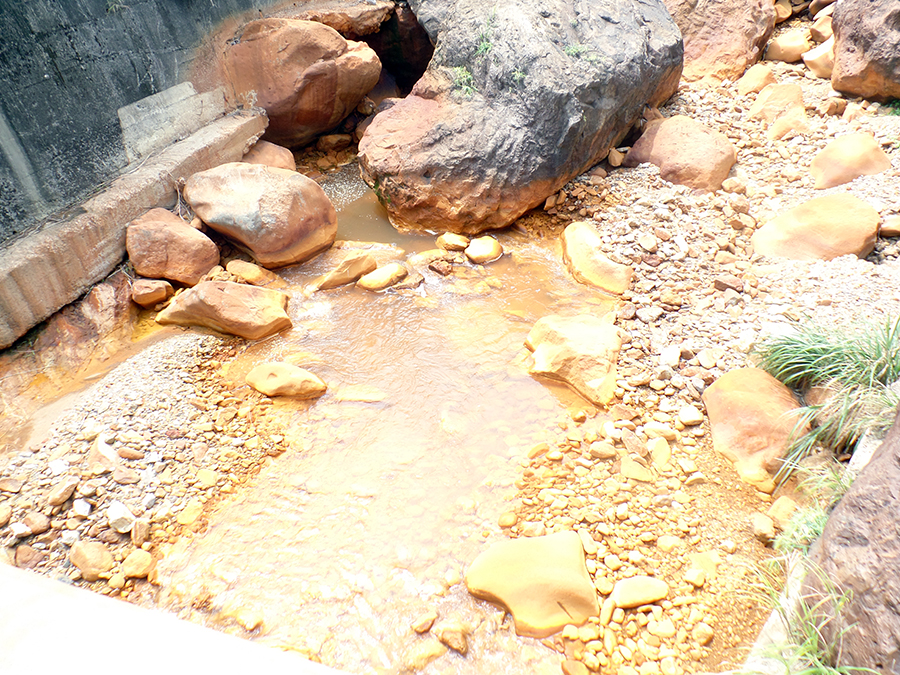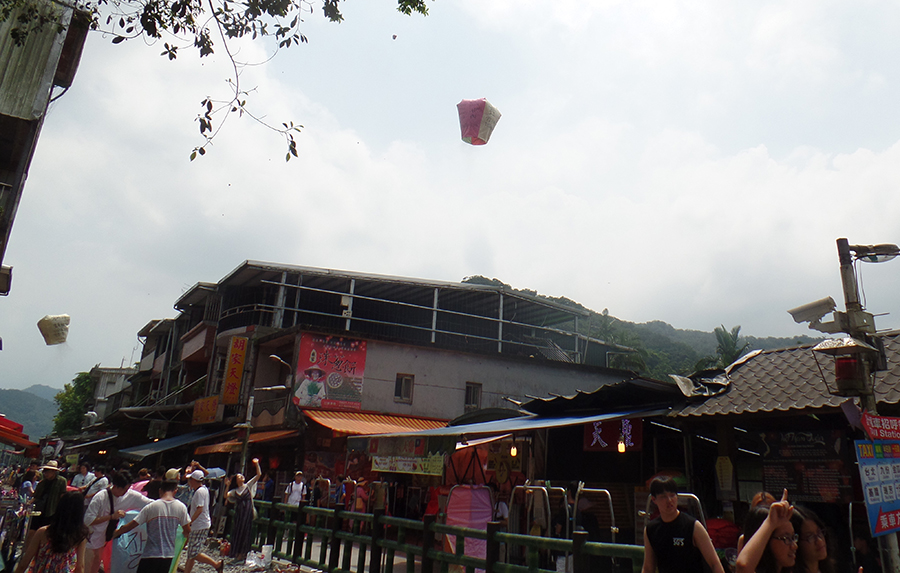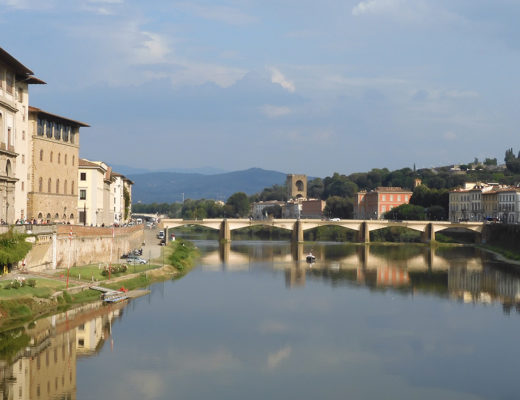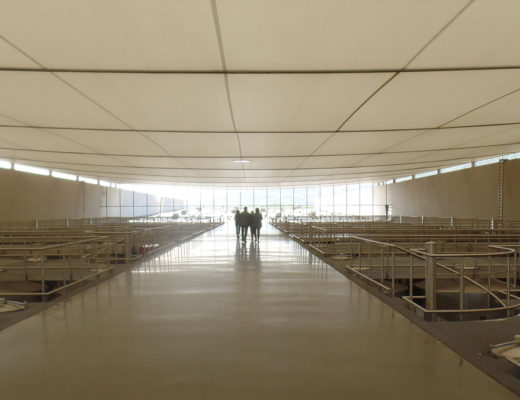During our recent trip to Taipei we decided to stay a day afterwards to see a little of the island outside of its biggest city. We contacted Yolo Taiwan (https://www.yolo-taiwan.com). They assigned Alan as our driver guide. Alan had also been our guide of our tour of Taipei and we were very happy to have him show us the northern coast of the Island and give us a little of its history.
The itinerary for this trip included the Yehliu Geopark, the Jinguashi Gold ecological park, Jiufen Old Street and the Shilen station to fly a lantern. While Yehliu is along the coast, the rest are more inland in the mountainous areas connected by very narrow and windy roads. Each point was about forty-five minutes apart by private vehicle with a knowledgeable guide.
The Yehliu Geopark, which is part of the North Coast and Guanyinshan National Scenic Area, has recently been rebuilt by the Taiwan government. Yehliu is one of seven such geoparks in Taiwan. Most of the walkways here are new as are the many bridges needed to traverse the waterfront geological features. Alan indicated that this park had become poorly maintained and had lost much of its natural attraction until the recent investment by the government. It is located at Wanli of New Taipei City and consists mainly of a long thin cape extending into the ocean. The rock layer now exposed at this site is made up of primarily limestone and therefore erodes quite quickly in geologic terms. The stones found at this geopark have eroded by the seawater to form many holes of varying size, but also shaped rocks that resemble, among other things a mushroom, candle, ginger, chessboard and the most famous is the Queen’s Head. If you were inclined to visit this location a recommendation would be to visit this later attraction first as the line to take pictures with this stone feature is quite long even at slow times of the day.

Queen’s Head in Taiwan
There are approximately 180 rock formations that resemble mushrooms. Some, with more narrow necks have taken on resemblance of other things, such as the Queen’s Head and multiple ‘cute princesses’. Alan told us it is important that there are princess rocks here because the government has warned that with another twenty or so years of erosion it is likely that the Queen’s Head may not be able to be sustained by the narrow neck that supports it. Thus the cute princesses will need to replace the Queen as the main attraction of this park.
The primary feature rocks are: Candle Rock, Ginger Rock, Mushroom Rocks, Fossils, Pot Holes, The Queen’s Head, Elephant Rock, Fairy’s Shoe, Earth Rock, Marine Bird Rock, Tofu Rock, Sea-eroding Cave, Weathering Ring, Pearl Rock and 24-Filial-Piety Hill. At this last location there is also a light house. At the park brochures explain the differing weather and erosion patterns that formed the various types of rock formations that remind one of the various names given them.
One feature that the weathering reveals is the large number of fossils found in the various rock formations. One of the most well known is one of a Sea Urchin.
Our next stop was Jinguashi to see the gold processing plant long ago abandoned by the Japanese Occupying forces in Taiwan. Alan explained that Japan occupied the island twice, once in the late 1800s when the gold mining operations were built and operated, and again in 1940 until 1945. Beside the processing site is a creek that runs down from the top of a nearby mountain which had provided water to the gold extraction and refining process. The stones in the creek remain gold in color today from the mineral content of the water that runs over them, even though the gold deposits were played out decades ago. A little further up we came to a water falls that has a gold glint to it again because of the mineral content of the water flowing through this area.

Gold River
Alan explained that the people who worked in the gold operations moved into the nearby village of Jiufen, which is on top of the mountain overlooking this site. When the Japanese arrived to begin operations there were only six people living on the main street of Jiufen, but that rose into the hundreds of workers. Today the main street drops dramatically as you come down from the top and a major cross street also has a wide variety of shops. Alan took us to one on the cross street that has been recently refurbished in light colored woods and is air conditioned, something that most of the restaurants do not offer. We had sushi, a cold seafood salad, a mango smoothie and Alan had both a chicken-leg soup and seafood pudding. I even had Saki with the meal and paid for all of us half of what one meal alone would have cost in Taipei. Everything was very good as well as being refreshing on a hot day.
Across the street from the restaurant is a Japanese Tea House. It has several areas for the sea service, a coy pond with waterfalls that provides a background of pleasant sounds for the visitors who come here to relax and enjoy what Alan described as the best Oolong tea in Taipei. He informed us that he comes here periodically with his new wife just to enjoy the relaxation and the views from on top of the hill. We wandered amongst the shops including one that had the most extensive collection of Buddha statues and other Asian religious figurines I saw anywhere on this trip. And it was in a very small shop in comparison to some of the stores we visited in Taipei City and Tokyo or Kyoto earlier on this trip.
Having recharged with lunch and visits to the many shops we were now on our way to Shifen where Alan informed us we would fly a lantern. It took nearly an hour to reach this remote village which has a tourist train coming up to it from Taipei City. Alan said the train takes about two hours although it would only take us about forty-five minutes to drive it. The train is important because the train track is where the lanterns are launched. Alan mentioned that as many as a thousand lanterns are launched each day. He took us to a shop that was at the other end of the row of shops. Here we purchased a lantern that is four-sided, with four different colored rice papers. Each color represents some aspect of your life about which you wish to ask for good luck. We chose the four aspects we wished to ask for luck about: Health, happiness, wealth and employment. We were then given a lantern that hung from a rack where we could paint with black ink and a brush what specifically we wanted to ask for. There were two sides so we each took one side, wrote our request, then changed sides and completed the other’s request. They changed the rice papers so we could repeat this process for the other two areas of fortune we wished to address.

Lantern Launch
They then took us out to the train track where one person inserted a small burner into the lantern, and lit the candle. As the heated air filled the lantern, the shop owner took our picture holding the lantern together, rotating it so we have a record of the requests we made. When the lantern was filled with hot air, we released it and the shop hosts took pictures of it rising into the sky so we have a record of its ascension.
On the way back to the car, Alan told us the lantern tradition started when miners lived in this village mining both gold and coal. The miners would release a lantern so their families would know the miners were all right.
We found the North Coast to have an extensive elevated highway system for major roads back to Taipei and an even more extensive labyrinth of windy narrow roads into the mountains and tiny villages. But people were friendly but not pushy about purchasing trinkets or food from the many stalls. But when you showed interest they were very pleasant and would take time to explain not only what you were interested in, but not insistent on buying something when the item of first interest does not meet your needs.
What we did discuss on the way down from Jiufen was the similarity of the mountaintop town to Taormina in Sicily near Mt. Etna and Jerome, Arizona, a played out former copper mining town that has become a tourist destination. Having visited all three, we found that interesting people live in such towns and interesting people come to visit them, to try to understand what life was like in these remote places at their peak and how they have completely changed the economy into something else.
The more time we spend in Taiwan and Taipei, the more our opinions of both have changed for the better because of the traditions we have been shown, the people we have met and the resilience that the human spirit has regardless of the circumstances in which they find themselves.





No Comments